|
I am posting what I gave to the Neighborhood & Long Term Planning Committee in September.
0 Comments
September, 2019
Let me start with a relevant quote from the U.S. Interior Department: "The nationally recognized standard for the treatment of historic properties, whether a colonial-period icon or midcentury modern streetscape, is the Secretary of the Interior’s Standards for the Treatment of Historic Properties, which provides, in part, that “The historic character of a property will be retained and preserved. The removal of distinctive materials or alteration of features, spaces and special relationships that characterize a property will be avoided.” Cambridge Brickwalk Conservancy's (CBC's) goal in this Committee hearing is to foster the establishment of a formal Cambridge sidewalk policy to direct the work of the Cambridge DPW and its contractors when they undertake construction projects in the City that result in removal of legacy brick sidewalks. The policy would make formal the long-standing guideline of replacing brick sidewalks disrupted by construction with brick (not concrete) after construction is completed -- and to encourage large scale new construction projects to install sidewalks made of brick rather than concrete. Sadly in recent years the exact opposite has been happening. In the absence of formal guidelines for the DPW, the Department has embarked on a policy of replacing disrupted brick sidewalks sometimes partially with brick and partially with concrete -- or at other times wholly with concrete. Two recent examples underway this month are illustrated in the photos on this website and also on our FaceBook page. While in the past City documents have stated brick sidewalks disrupted by construction would be replaced with brick, a new policy is being advanced in a draft put out by the Cambridge Commission for Persons with Disabilities (CCPD) and sent to its members for approval. Here is what Cathy Watkins, Cambridge's Chief Engineer, is noted in Committee minutes as telling the group: Sidewalk materials:
Should the DPW be setting this radical new sidewalk policy by default without City Council or citizen input? Concrete fringed with brick (at best or all concrete in many places), if implemented city-wide, will over time eliminate the City's signature brick sidewalks along with the City's distinctive historical character. At the hearing I supplied detailed information about how a nearby town is dealing with this issue: · The Executive Summary of the Lexington Ad Hoc Committee which among other things proposed that after construction disrupting town center brick sidewalks, removed brick will be replaced with brick.
https://www.lexingtonma.gov/planning-office/center-streetscape-design-review-adhoc-committee We have studies showing that wire cut brick produces less vibration than concrete for wheelchair users. Also, there is now a study showing that wire cut brick is less slippery than concrete. I will do a blog to show the results of the British Pendulum test performed by the UMass Dartmouth materials lab. Life Cycle Costs of Material Options for Sidewalks
In Cambridge, the current sidewalk plan allows for two different options for sidewalk materials: poured concrete or wire cut brick. A logical question arises: Which choice is better for the long run? The long run being a 40 year life cycle. To answer this question we must consider certain variables that come into play: -- Initial installation cost per square foot -- Compressive strength of the different materials which, in turn, determines the durability of the material when subjected to day to day wear -- Maintenance cost over time which, in turn, is a function of how well the materials hold up. Concrete has an advantage in initial installation cost at $55 per square yard versus $275 for wire cut brick (according to a sidewalk installer with Architectural Paving and Stone of Weymouth, MA who has worked in Cambridge). Wire cut brick has 4 to 5 times the compressive strength of concrete (12,000 to over 14,000 psi for brick versus only 3,000 psi for concrete). This difference shows up in durability over time in New England weather conditions. It has often been observed that concrete deteriorates not too long after installation, crumbling within 10 years commonly or experiencing up-thrust slabs from root growth or frost heaves. Wire cut brick lasts for the long run. Any displaced bricks can be readily reinstalled with modest effort. Maintenance cost is far less for wire cut brick compared with concrete. Experience shows concrete crumbles within 10 years or less so would have to be materially maintained at least four times in a 40 year period. Brick, on the other hand, is far more durable and needs minimal maintenance in a 40 year period, if sand-set, mainly resetting displaced individual bricks due to root growth or slippage in place. According to the Vice President of Sales and Marketing for Pine Hall Brick of North Carolina, the maintenance cost per square yard over 40 years is $220 for concrete but only $18.33 for wire cut brick. Which means the 40 year life cycle cost of the two materials per square yard is $275 for concrete and $293.33 for brick. Reinforcing this point is what little data we could find on maintenance costs incurred for sidewalks in Cambridge. Concrete maintenance and repair cost was over $20 million in the past 10 years versus negligible for brick. All in all, it would appear that use of concrete for sidewalks is penny wise and pound foolish. Brick would appear to be the clear choice for the long run, not to mention the fact that brick is consistent with the historical legacy of brick sidewalks that the City has had for more than 200 years. Reinforcing this point is what little data we could find on maintenance costs incurred for sidewalks in Cambridge. Concrete maintenance and repair cost was over $20 million in the past 10 years versus negligible for brick. All in all, it would appear that use of concrete for sidewalks is penny wise and pound foolish. Brick would appear to be the clear choice for the long run, not to mention the fact that brick is consistent with the historical legacy of brick sidewalks that the City has had for more than 200 years. Regards. Diane 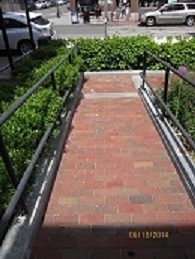 Portland, ME, is an example of what can be done to keep the legacy of brick sidewalks intact while satisfying the needs of the disabled. I looked into how Portland accomplished this feat. I spoke with people who are or were in city government and who helped to shape the city’s policy. In the 1970s the city decided to preserve and repurpose the old buildings built in the 1860s. The city saw value in this area and developed a Sidewalk Material Policy (revised in 2010) to insure that it kept its brick sidewalk legacy to complement the historic buildings. People began to be drawn to the area as a consequence of the preservation of the city’s architectural history and, as the city revived, new businesses and restaurants slowly began to open until Portland became the vibrant city once more that it had been in the mid-19th century. Authenticity of materials is important in the historic districts. In these districts bricks are required (with an exception for industrial sites if so elected). Over the years the city has tried different types of brick and methods of installation. Brick now used that evolved from the process is still molded brick but, unlike legacy brick, is flatter and more uniform which means a better surface for the disabled and for snow plowing. Texture has been added to the bricks to make them less slippery. Portland’s sidewalk policy assures maintenance of both brick sidewalks and ramps in the historic district. If brick is removed for construction, either on the flats or the ramps, then the sidewalks and ramps are restored with brick after the construction is completed. Concerning the ramps, assuming a less than 10% incline (universally the case for Cambridge ramps), either wire cut brick or modified molded brick (as described above) can be used and meets the needs of the disabled. Cambridge could also do this. It is difficult to put a precise dollar value on maintaining historic districts which draw many visitors to our city. However, if you walk through Harvard Square and Harvard Yard you get the feeling for the draw of our history. The many visitors to this area spend money in our restaurants and other retail businesses. It is important to maintain these areas to preserve the legacy that draws so many visitors from around the country and the world. Below is a photo of a beautiful brick ramp on Brattle Street. Pouring asphalt over brick sidewalks is not the answer. Asphalt may be acceptable as a temporary fix but in many instances around Cambridge, it has been the fix for years. Below is one of our streets patched with asphalt. Support to maintain our brick walk legacy is necessary and should be a partnership in the city not only for historic preservation but also safe streets for all. Money should not be the issue for the areas that draw so much interest in our city.
Here's a recent interview that was posted online at SCOUT Magazine.
POSTED BY: EMILY CASSEL There are a lot of things that make Cambridge such a beautiful city - the architecture, the foliage, the views of the Charles. But ask Diane Beck, and she will tell you: It also has something to do with the ground you are walking on. "The brick around the new Harvard Museums is wire-cut brick, laid very closely, and it is really a smooth ride," Beck effuses. She is the vice president of the Cambridge Brickwalk Conservancy, a nonprofit that's looking to preserve and maintain the city's brick sidewalks. "People know me as ˜the brick lady,'" she says, laughing. Our main purpose is to preserve the brick legacy that - I think - attracts a lot of visitors to Cambridge. That make it not just a concrete jungle. Since the nonprofit got its start in 2013, she and other members of the conservancy have spoken to city officials, city council, the Department of Public Works and professors at area universities to determine how they can encourage further implementation and preservation of the city's bricks. According to Beck, this has long been a passion for her and for CBC president and director Jack McMullen. The pair believes that diversity of people, of restaurants, of businesses and, yes, of walkway - is what makes cities beautiful. "There's a history that goes back 100 or more years,,Beck says,, "and just to tear it up and put more concrete in isn't doing a good job. " Beck admits that brick is more expensive than other building materials. ("At the moment, the DPW will tell you it is much more expensive to have brick than concrete," she concedes.) But whereas concrete gets pitted and cracks and lifts, she says she believes brick actually lasts longer. She adds that, in conversations with the differently-abled community in Cambridge, she's learned that even concrete isn't always that great - especially slabs that have wide openings in between them. That's been a concern for her, as unkempt and uneven brickwork - like cracked concrete or asphalt - can be a hazard to those traveling in wheelchairs or with the aid of a walker, crutch or cane. "We also want to make these brick sidewalks good for everybody, not just for the population that can see, hear and walk easily," she says. As a member of a very small team with a very niche interest, Beck says it's taken a little while to drum up support for the Brickwalk Conservancy's cause. But now, in addition to working with city officials and the DPW, she wants to get the public involved, a strategy that she says seems to be working so far. I'm now getting emails from folks saying, ˜You are absolutely right -”what can we do?" Beck says. "So I know we are getting somewhere." You can learn more about the Brickwalk Conservancy, including updates on events and information on how to contact The Brick Lady herself, at cbc-brick.org . July 2016
Independence Day weekend is behind us already. We hope that you enjoyed it and were able to partake in some of the celebrations with fireworks. Cambridge has put its five-year Sidewalk and Street Reconstruction Plan on line. The plan is clear and the drawings were well done. Unfortunately, it looks like Cambridge is committed to allowing bricks to remain only in historic areas. Elsewhere, the City plans to install brick only as a decorative feature on the fringe of concrete sidewalks or in construction sites where the resident and/or business owner states his/her desire to install brick as an alternative to concrete and is willing to pay an extra cost. Streets where the City has recently implemented the brick-on-the-margin-of-sidewalks approach are Broadway and parts of Mass Avenue. Although a better look than all concrete, Cambridge is missing the point. In ongoing conversations I am having with disabled folks in and around Cambridge, I have learned many are for brick as a material as long it is installed correctly and maintained. Some have even commented that wire-cut brick gives a superior ride to concrete on sidewalks. Of course others favor concrete apparently unaware of the problems inherent in use of concrete: rapid deterioration in harsh New England weather resulting in pitting and crumbling and/or the tendency for slabs to be up-thrust several inches by tree roots or frost heaves. In addition, according to what I have been told, concrete performs best when it has saw-cut rather than hand-formed grooves, which create a bumpier ride for wheeled mobility devices. Budget limitations have resulted in not following best practice and have also reduced the number of inspectors who might have caught and corrected the problem On a related matter, there was a study done by the University of Pittsburgh which has been mentioned in this blog previously (which showed wire-cut brick lasts longer and rides smoother than concrete) that some in the disabled community say was funded by the Brick Industry. Totally untrue.. I checked this fact about two years ago with Dr. Jon Pearlman who was the lead person on the research. The brick industry funded less than 10%. But once incorrect information is in the public domain, it is difficult for the truth to displace it.. We all want safe sidewalks for public use. CBC does not advocate compromising safety, especially for the disabled, but strongly believes the City can maintain its historic brick sidewalk legacy by changing its sidewalk plan to encourage the use of wire-cut brick wherever concrete is now specified. CBC would particularly want to discourage the City’s recent practice of ripping out legacy brick sidewalks and replacing them with a pale imitation: concrete with a fringe of brick. Our brick sidewalks distinguish Cambridge from other American cities by reflecting times long past and subtly connecting present Cantabridgians with that past. Here are two examples of dysfunction in the current plan. On Lexington Avenue, Cambridge, sidewalks were re-constructed in concrete two years ago. After the installation It took less than 12 months for the concrete to pit and lift (called chipping.) Separately, we were contacted by a person who wanted brick in the Huron Avenue area which has been under construction for some time. He was told it was too late to change anything. It is difficult, if not impossible, for a resident to get ahead of the decisions on materials for these projects. DPW makes the decisions on materials and it has chosen concrete in all areas they control. In order to change materials, we need to hear from people who want to see change. Please feel free to contact us at dianecbc@verizon.net. Hope your 4th was a good one! Diane 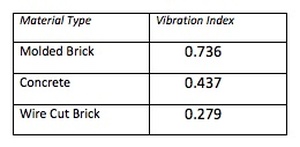 An advocacy piece appeared in Globe Magazine on November 29, 2015. It discussed difficulty in navigating the brick sidewalks of Beacon Hill from the point of view of one disabled person, Tommye Mayer It seemed to promote ripping out or substantially modifying brick sidewalks in historic areas to assure that persons like Tommye Mayer or Boston’s aging population can have a smoother walk in downtown Boston. What is so troubling about the article is that it gave no consideration to the unique contribution Boston’s brick sidewalks make to the city -- they are a precious legacy left us from generations centuries past that add so much to the beauty and charm of Boston. Bostonians who like brick sidewalks and enjoy their beauty were given no deference. Cambridge Brickwalk Conservancy (CBC) recently conducted a focus group with wheelchair bound folks, both male and female, from 38 years old to 78 years old, we learned that they all felt that the sidewalks of Cambridge could be improved. Their concern was not the material used for the streets per se. What was important to all of them was a smooth ride which allowed for safety, less vibration and jostling, flat areas wherever possible so that they could feel dignified. Their goal is independence. A balanced approach to the City’s sidewalks would permit all pedestrians safe travelling. Vibration was the subject of 2003 research at the University of Pittsburgh led by Annmarie R. Kelleher, OTR/L, Rory A. Cooper, PhD, Erik Wolf, MS, Shirley G. Fitzgerald, PhD, and Jonathan Pearlman, MS. Funding was provided by the VA Rehabilitation and Development Service, Veterans Health Administration, U.S. Department of Veterans Affairs, and the U.S. Department of Education, National Institute on Disability and Rehabilitation (NIDRR) Rehabilitation Engineering Research Center on Wheeled Mobility. The results of testing in 2002 and fifteen months later in 2003, demonstrated that certain brick sidewalks had less vibration than several other types of pavers as well as concrete. Bricks with squared edges demonstrated the least amount of vibration at both the seat and footrest among all the surfaces, including concrete. The front casters of wheelchairs “catch” the breaks or cracks between the concrete sections causing increased vibration levels. The front casters are usually small in diameter and loaded with less effective mass, they detect more subtle changes in the surface profile than at the seat. The table below uses data from the 2002 and 2003 study at the University of Pittsburgh which gives the vibration comparison of brick pavers with concrete. Given this engineering data, it turns out we can serve the disabled, like Ms. Mayer and the elderly and preserve the City’s legacy by using properly installed and maintained wire cut replacement brick whenever construction leads to molded brick removal. Wire cut brick results in less vibration than concrete. In fact, this was done on Dartmouth Street after the MBTA installed a elevator for the disabled from the subway stop below to the street above through the brick sidewalk in that location. In researching other cities with historic brick sidewalks, we found that Portland, ME, has taken a diametrically opposite approach to the brick sidewalks from that now being taken by Boston. Portland has recently decreed that brick sidewalks will be preserved or installed in its designated historic districts. This policy shift has resulted in the removal of ugly concrete ramps previously installed in these districts. In their place are newly constructed wire-cut brick ramps of the very type we have been encouraging Cambridge and Boston to consider. The photo below shows a recently installed wire cut brick ramp in Portland. Citizen groups are also involved in preserving the brick legacy. For example, the Kindling fund in Portland, ME, has sent aside $5000 to stamp stories into bricks used to fill gaps in the brick sidewalks. The stories imprinted are those city residents deem significant, such as historical facts, individual memories, and future wishes for the city.
Preserving brick sidewalks preserves as well our link to the past – and adds immeasurably to the unique character our city. And, we now know that this can be done without compromising the ease and comfort of the disabled through the use of wire-cut bricks for ramps. Tidbits from our Focus Group
We have made it through January and February into March without heavy snow. But this is New England and we never know what Mother Nature will throw our way. I have been thinking about the information I received from a focus group we did in December with participants who were in wheelchairs and scooters. We discussed everything from the state of the streets, to the materials used, to the cost involved. The focus group participants started the discussion by giving their opinions of the state of the sidewalks they use. Many sidewalks have holes in them – either bricks missing or the concrete pitting turns into holes. Also, tree roots lift the concrete and loosen the bricks which make it difficult to traverse the streets. The group did not have a preference for materials as long as the sidewalks are level and smooth. The group also seemed okay with concrete but noted that it is pitted, the spaces are too wide and it heaves more than bricks. After some discussion they agreed it was not the material but that the material be smooth. According to one of the participants, there is a stretch of brick in Central Square is a pleasure to ride over. If more brick sidewalks were like that, brick would be very acceptable. So the City is capable of laying good brick sidewalks which are pleasant for all pedestrians. We would like to see more of this. I asked if the participants were open to using different materials for ramps if they could accomplish the same purpose – ease of getting into the street safely. One of the participants said the ramps at the apex were not safe. They are too big and when taken to get into the street, there is a danger of being hit by passing car. The size of the apron was not important to the group. They did mention that there is a jolt where the ramp ends in the street no matter what material is used and it can hurt your back. This discussion was followed by one woman’s account of her wheelchair falling over going down a ramp. I asked if it was a brick or concrete ramp and was told it was a concrete ramp. They did not know if this was caused by a poor design or installation of the ramp. Considering that wheelchairs may weigh 500+ pounds this is very dangerous. I will address more of their comments and concerns as the year goes on. I hope to meet and hear from others so that we may do better in the future. Walk and ride safely. Diane When you are walking in Cambridge, think about three well known figures who walked these streets in the 19th century when many of them were ribbons of continuous brick: E. E. Cummings, Oliver Wendell Holmes, and James Russell Lowell. As previous blogs have discussed, since the late 1990s when Cambridge policy toward this unique heritage changed dramatically, the City has been busy transforming its brick sidewalk legacy in many ways (none of them good). Whole stretches of brick have been removed along Broadway, in East Cambridge, Cambridgeport, the Agassiz neighborhood, and others. Where wholesale removal of brick has not been the case, wide swaths of brick have been removed, even in the most sensitive historical areas, to install -- at taxpayer expense -- extensive, ugly, bright white ramps at virtually every street corner. Given the callous disregard for its brick sidewalk legacy that Cambridge has demonstrated in recent years, we thought it would be instructive to see what is going on both in New England and other, far-flung parts of our country related to the treatment of historical brick installations. This blog will focus on two nearby cities, Portland, Maine and Salem, Massachusetts, two communities that have taken a diametrically opposite approach to their brick sidewalks from that taken by Cambridge. It will also highlight briefly 12 other cities that have recently awakened to the importance and value of installed brick inherited from the past and are taking measures to preserve and enlarge those installations. In those parts of the country brick streets are more prevalent than brick sidewalks but citizens value them just as much. These 12 cities will be discussed in detail in a subsequent blog. Let’s start with Portland. The city has recently decreed that brick sidewalks will be preserved or installed in its designated historic districts. This policy shift has resulted in the removal of ugly concrete ramps previously installed in these districts. In their place are newly constructed wire-cut brick ramps of the very type we have been encouraging Cambridge to consider. Citizen groups are also involved in preserving the brick legacy. For example, the Kindling Fund in Portland ME has set aside $5,000 to stamp stories into bricks used to fill gaps in the brick sidewalks. The stories imprinted are those city residents deem significant, such as historical facts, individual memories, and future wishes for the city. Think how this artistic approach would add interest to Cambridge brick sidewalks for tourists visiting the city not to mention on regular historic tours given in the city. Here are three photos of Portland brick sidewalks in its fabled historic district reflecting that city’s care and preservation of them. Salem is another city that has been careful with its historical brick sidewalks as can be seen from the two photos below taken at the Visitor Center and near the Peabody-Essex Museum across the street. In addition to these two local cities, the drive to revive and preserve
brick streets and/or sidewalks inherited from past times has recently occurred in many places across the United States. A few of them are highlighted below. Champaign, Ill. Ban paving over brick. Spend $100K to maintain brick streets. Winter Park, FL. Removed layer of tar previously installed over brick streets. Cumberland, MD. Expanded brick street preservation another 6 square miles. Brooksville, FL. Removed pavement to expose brick streets. Amarillo, TX. Spend $200K to restore one block of brick street. Plan to do more. Blair, NEB. Shelved plan to pave over city's dilapidated brick streets with asphalt. Bedford, OH. Historic brick streets kept after it was proved the town could save money in maintenance over long run. Davenport, OK. Citizens up in arms over plan to pave over the bricks on main street. Showdown averted when money for project dried up. Wilmington, NC. Tests process to uncover brick streets. Blairsville, GA. "Preserving the Past for the Future." Tampa, FL. Fight to preserve brick streets. Houston, TX. Work stopped to remove bricks from street for utility work. Money was earmarked by Federal Government to preserve bricks. Going to court averted. So what are the lessons to be learned for Cambridge from this activity in our region and across the country? Preserving brick sidewalks preserves as well our link to the past -- and adds immeasurably to the unique character of our city. And, we now know that this can be done as in Portland without compromising the ease and comfort of the disabled who travel the sidewalks through the use of wire-cut bricks for ramps. Wire-cut bricks cause less vibration than concrete and hold up better over time. Also, unlike with concrete, bricks do not manifest the problem of entire slabs being up thrust by growing roots. I hope that you are enjoying your summer and that if you have photos of beautiful brick sidewalks you have encountered in our region or on your travels, please send them along. Regards, Diane Whitney Beck Hello! Summer has officially arrived and our newest intern is in the office working on projects. The Cambridge Brickwalk Conservancy, Inc. (CBC) team was at the Make Music event in Harvard Square on June 20th sponsored by the Harvard Square Business Association. Our table was set up on Brattle Street midst brick sidewalks in that historic section of the City. In the course of the event, we spoke to Cantabridgians who were very supportive of preserving the legacy of brick sidewalks in the City while making them safe for everyone. Tourists going by our table were also able to appreciate this unique characteristic of historic Cambridge. The shopkeepers I know have said legacy brick sidewalks are a unique draw and would like to see them preserved and maintained. Maintaining what we have without using asphalt as the main patch material would be a great improvement. I am sure that the patches were meant to be temporary but are now permanent (or is several years temporary?) At CBC we are campaigning to galvanize what we are told is strong (but unorganized) support for brick sidewalks in Cambridge. The Beacon Hill Civic Association (BHCA) recommended wire-cut bricks be used for ramps in its historic neighborhood and architectural cast concrete pavers be installed for the detectable warning pad. The US access board has said that properly laid brick is just as ADA compliant as poured concrete. The warning-pad pavers can be made in any color and can be made with the same audible echo as the plastic pads. As a benefit, they are 1/3 the cost of the plastic pads and possibly have a longer lifespan. Back in Cambridge, you may notice that many of the currently installed warning pads already need repair. As a consequence, the Cambridge DPW is trying to find and test more durable warning pad material. The concrete warning-pad pavers suggested by the BHCA would seem to fit the bill. Cambridge Brickwalk Conservancy agrees with the BHCA that it is possible (and desirable) to satisfy both the ADA guidelines and historic preservation guidelines without compromising either. And, as the BHCA pointed out. it is critical to do so to preserve our historic legacy. We will continue to campaign for a policy that better balances the needs of the disabled with the importance of preserving historic brick sidewalks in Cambridge. The charm and beauty of this feature need not be lost because of a false belief that serving the needs of the disabled requires relentless degradation of the City’s brick sidewalks. Best wishes, Diane Beck, VP of Cambridge Brickwalk Conservancy, Inc. |
AuthorDiane W. Beck
VP and Board Member Archives
December 2019
Categories |
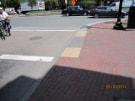

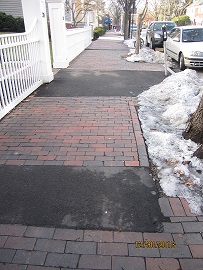
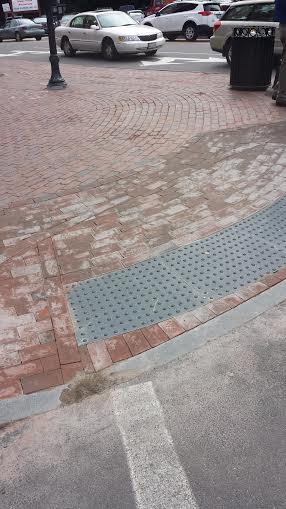
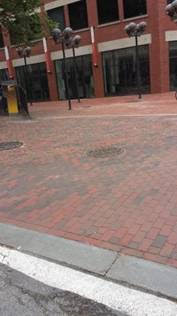
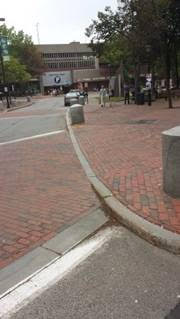
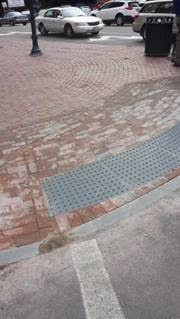
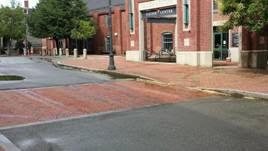
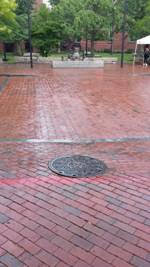
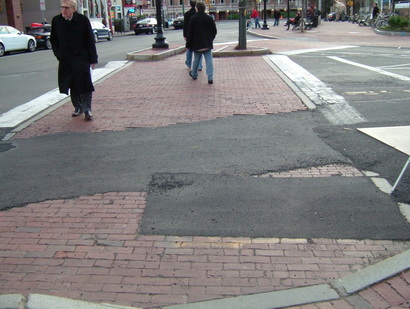
 RSS Feed
RSS Feed